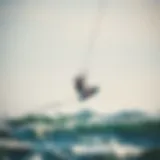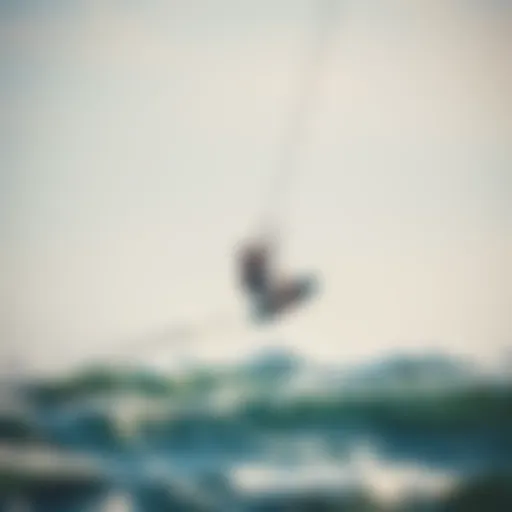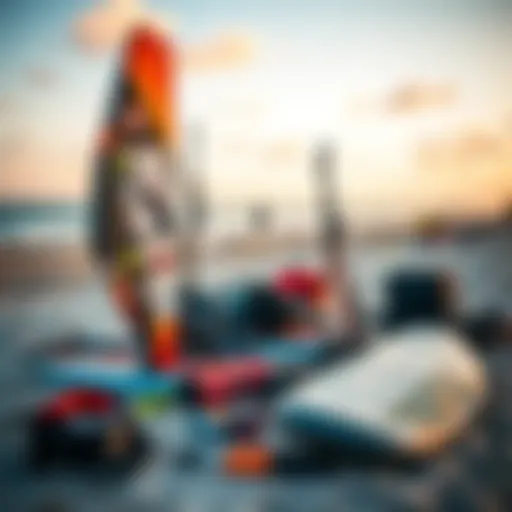Windsurf Wing: Evolution and Techniques for Enthusiasts
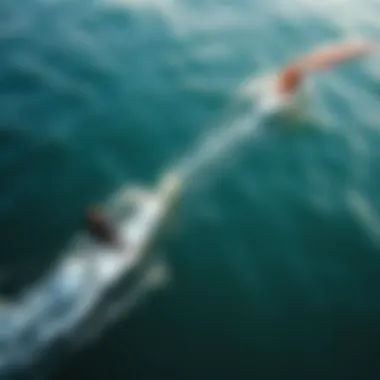

Intro
The evolution of water sports has taken quite an interesting turn, particularly in the branch of windsurfing. Not so long ago, the windsurf wing was merely a concept floating around in the minds of a few adventurous spirits. Today, it stands at the intersection of innovation, excitement, and functionality. For enthusiasts eager to ride the winds, this shift means thrilling possibilities and new challenges.
With the rise of various gear and techniques tailored specifically for the windsurf wing, it’s essential to dive into the nitty-gritty of what makes these wings soar. Whether you're a seasoned pro or a novice looking to dip your toes into the world of windsurfing, understanding gear, tactics, and safety can enhance your experience significantly.
Let’s embark on this journey through the fascinating landscape of windsurf wings—examining how their design has adapted over the years, pinpointing what gear experts recommend, delving into advanced techniques, and recognizing crucial safety practices. This comprehensive guide aims to elevate the knowledge and skills of those who seek the thrill of harnessing wind and water with a windsurf wing.
Preface to Windsurf Wings
Windsurf wings represent a cutting-edge evolution in the realm of water sports, combining the artistry of wind power with the thrill of surfing and sailing. As enthusiasts pursue the ultimate adrenaline rush on natural waters, understanding the essence of windsurf wings becomes crucial. They offer a unique blend of performance, agility, and versatility, making them a magnet for individuals from all walks of life, be it recreational surfers or seasoned racers.
Definition and Purpose
At its core, a windsurf wing is a specialized piece of equipment designed to harness the breeze. Unlike traditional sails, these wings provide a higher level of control and maneuverability. With the principles of aerodynamics at play, the design supports efficient lift while minimizing drag.
The primary purpose of a windsurf wing is to catch the wind effectively, allowing riders to glide smoothly over water. Riders can quickly pivot or change direction thanks to the wing's unique construction, enabling agile and fluid movements. This adaptability is particularly beneficial in various conditions—from tranquil lakes to coastal waves. It’s no longer merely about riding the wind; it’s about mastering it.
Historical Context
Windsurfing as a sport traces its roots back to the late 1960s and early 1970s, when pioneers experimented with different rigs and boards that eventually led to the designs we recognize today. The evolution of windsurf wings is intertwined with significant advancements in materials and design philosophy. Initially, riders relied heavily on bulky sails made from less durable fabrics. Gradually, innovations allowed for sleeker profiles and lighter materials, transforming the user experience radically.
The introduction of wings has been revolutionary. Originally, wings started as small, rigid structures attached to traditional boards. Over time, these evolved into larger and more flexible designs, reflecting a significant leap in engineering. In the late 2010s, the sport saw a surge in innovations, particularly focused on carbon fibers, which enhanced performance and reduced weight.
"Understanding the intricate dance between wind, water, and the surfer is pivotal for anyone serious about mastering windsurf wings."
As windsurf wings gained popularity, communities and competitions sprouted up globally, from sun-soaked beaches in Hawaii to gusty shores along the British coasts. Each region brought unique challenges and innovations, contributing to the cultural tapestry of windsurfing today. Adventurers, thrill-seekers, and even families have found joy in windsurfing, underscoring the sport's universal appeal and solidifying its place in water sports history.
The Anatomy of a Windsurf Wing
Getting to grips with the anatomy of a windsurf wing is not just an academic pursuit—it's essential for any enthusiast looking to elevate their game on the water. Understanding the components can sharpen performance skills, optimize handling, and enhance overall enjoyment. When you dive into each part, you see how they work together to offer the exhilarating experience that windsurfing is famous for. Often, beginners overlook these details, but the truth is, mastering the anatomy can lead to smoother rides and more controlled maneuvers.
Wing Shape and Structure
The wing's shape and structure play a crucial role in its performance. Each design element influences how a wing interacts with the wind, which ultimately determines how effectively one can ride.
Aspect Ratio
In essence, aspect ratio refers to the relationship between the width and height of the wing. A higher aspect ratio generally means a longer and narrower wing, which grants better speed and more lift. Riders on boards equipped with high-aspect wings often find themselves slicing through water with less resistance, making it a preferred option for those chasing speed. On the flip side, low-aspect wings, being wider, offer enhanced control and stability, making them excellent for maneuvers.
Some characteristics of high-aspect ratios include:
- Increased speed potential
- Improved efficiency in lift generation
- Greater vulnerability to gusts, necessitating a steady hand
This choice comes down to the style of riding; racers might lean towards high-aspect wings, while leisure riders may find comfort with a low-aspect design, which suits casual cruising.
Profile Design
The profile design of a windsurf wing operates as the blueprint of its aerodynamic efficiency. Basically, it describes the wing's cross-sectional shape and how air flows over its surface. A well-designed profile can enhance lift while minimizing drag, thereby maximizing both speed and maneuverability.
Key characteristics include:
- Cambered profiles for increased lift at various speeds
- Flat profiles for easier handling in shifting winds
While complex camber might produce superb lift, novice riders can find it tricky to manage. Therefore, understanding the trade-offs here is key. The right profile design can either catapult a rider into a world of high performance or ground them with its demands.
Canopy Materials
Materials used in windsurf wings can significantly affect durability, weight, and performance. Modern wings often use advanced fabrics like ripstop nylon, which balances strength and lightness. Each material comes with its own set of pros and cons that affect how you handle the wing.
Consider the following:
- Ripstop Nylon: Offers good durability and UV resistance at a manageable weight. Great for beginners and experienced riders alike.
- Mylar: This film is ultra-lightweight but can be prone to punctures and may not hold up as well against the sun's rays over time.
- Dacron: Durable and stiff, making it excellent for larger wings, though it may lack the flexibility that some riders desire.
Balancing durability with performance is a critical task for riders. The right material can not only enhance performance but also influence the longevity of the gear.
Mast and Boom Compatibility
Compatibility between the mast and boom is another pivotal aspect to discuss. Utilizing the right combination ensures that you harness wind power effectively. A mismatched setup can lead to subpar performance, affecting everything from handling to control.
When selecting masts and booms, consider their flexibility, stiffness, and weight. While stiffer masts offer better power transmission, they might not accommodate the nuanced feel some riders prefer. Conversely, flexible masts might absorb some of the power, suiting casual riders better.
In summary, understanding the anatomy of a windsurf wing—from wing shape to material choice— can dramatically enhance riding experience and efficiency. A thoughtful approach to gear selection often leads to a clearer understanding of one’s riding style and preferences.
The Mechanics of Wind Power
Understanding the mechanics of wind power is foundational for riders who aspire to maximize their performance on the water. In windsurfing, the interplay of forces plays a crucial role in determining how efficiently and effectively one can harness the wind's energy. When you break it down, two primary forces come into play: lift and drag. Grasping these forces is like knowing your A's and B's if you want to navigate the waves skillfully.
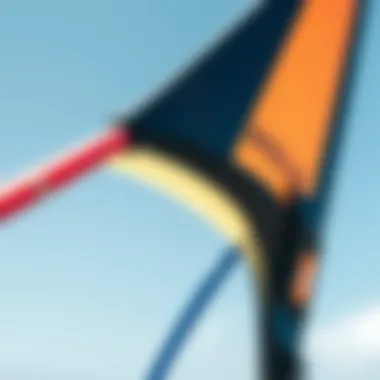

Lift and Drag Forces
Lift is the force that propels the rider upward and forward. It’s what gives the windsurf wing its magic, allowing it to glide effortlessly over water. Imagine a bird gliding on air currents; that’s what rider experiences with proper lift. On the other hand, drag acts contrary to lift, acting like an anchor that slows you down. It’s generated primarily by resistance as the board moves through the water and the wing slices through the air.
Key Considerations
- Balance: Striking the right balance between lift and drag is essential. Too much lift can make for a shaky ride, while too much drag can slow you to a crawl.
- Body Position: Adjusting your stance can influence these forces. Leaning back can help generate more lift, while fixing your weight toward the front can help combat drag.
- Wing Design: Modern wings are meticulously crafted to enhance lift while minimizing drag. The innovations in shape and design can lead to noticeable improvements in performance.
For anyone looking to excel in windsurfing, understanding the mechanics of lift and drag is like having the cheat codes for the sport.
Wind Dynamics
The dynamics of the wind further enrich the experience of riding a windsurf wing. Wind dynamics involve various elements, such as wind angle and speed variations, and grasping them enhances your control and adaptability on the water.
Wind Angle
Wind angle refers to the direction of the wind relative to your position. It is a vital consideration for maximizing speed and control on your board. A key characteristic of wind angle is the concept of apparent wind, which encompasses not just the natural winds but also the wind created by your own movement.
- Optimal Angling: Riders should strive to position themselves so that they can catch the optimal angle of wind for lift. Angling into the wind can create more speed and better control.
- Tactical Advantage: Understanding how to read and respond to changing wind angles can be the difference between a smooth ride and an arduous struggle.
- Unique Feature: The ability to adjust to wind angle optimally allows riders to manage lift and drag effectively, enhancing performance while navigating varied conditions.
Speed Variations
Speed variations, particularly how fast the wind blows at different heights, can greatly alter a rider's experience. When talking about speed variations, it refers to how strong or weak the wind can be in different conditions.
- Adaptive Skills: As a windsurfer, being able to adapt to fluctuating wind speeds is crucial. If you’re sailing in lighter gusts, you might need to alter your technique for maximum effectiveness.
- Consistent Performance: Recognizing speed variations and making the necessary adjustments can propel you to outstanding performance levels.
- Advantages and Disadvantages: While higher speeds can lead to thrilling rides, too much can compromise stability, particularly for riders newer to the sport. Learning to navigate these choices can elevate your skills.
Grasping the elements of lift, drag, wind angle, and speed variations arms enthusiasts with the knowledge necessary for a dynamic riding experience. By learning to work with these forces instead of against them, riders can unlock new levels of performance and enjoyment in their windsurfing pursuits.
Techniques for Effective Usage
Understanding the techniques for effective usage of windsurf wings is paramount for any rider looking to improve their skills and enhance their enjoyment on the water. Techniques that enable smoother launches, seamless transitions, and precise maneuvers can significantly transform the experience of windsurfing. Not only do these skills contribute to the overall performance, but they also ensure safety and enjoyment while navigating various environments.
Launching and Recovery
Launching and recovering a windsurf wing may seem rudimentary, yet it is a critical skill that requires practice and awareness. The initial phase of a session starts with a proper launch. To make this happen smoothly, the rider must position the board at an angle to the wind to catch it effectively. By holding the wing above the head at a slight angle, the wind can fill the canopy, and lifting becomes much easier.
When it comes to recovery, the strategy varies based on the conditions. If the wind is strong, a controlled descent is vital. Riders should practice coming down gradually while keeping an eye on the board to avoid mishaps. Using the wing to steer into the wind can assist in a safer retrieval, keeping the rider’s safety paramount.
Turning and Maneuvering
Turning and maneuvering are where riders can truly showcase their skills, turning a standard windsurfing session into an exhilarating experience. Mastering these techniques allows riders to navigate through various courses and optimize speed.
Carving Turns
Carving turns represent a graceful and artful way to change direction on the water. This technique hinges on shifting weight and positioning the body correctly. Riders will often initiate a carve by leaning into the turn, which allows the board to cut through the water seamlessly.
The key characteristic of carving turns is the way it preserves speed while changing direction. Compared to a simple pivot turn, carving provides a more fluid and faster transition. As for its advantages, carving turns enable riders to maintain momentum, making it a favored choice for both novices and veterans alike who want to showcase finesse.
However, while carving, it’s critical to account for the wind conditions—too much lean can lead to an accidental wipeout. Thus, understanding one’s limits is crucial to enjoy the spiraling movement without losing balance.
Jibing Techniques
Jibing techniques are essential for making smooth transitions while changing direction downwind. This maneuver requires precise timing and coordination. To successfully jibe, riders must understand when to switch their grip on the wing and prepare to shift their weight.
The hallmark of effective jibing is the seamless switch of control from one side of the board to the other without significant loss of speed. This is why many riders find jibes not just useful but also rewarding, allowing for quick direction changes while still keeping up pace.
Unique to jibing is the necessity of understanding wind shifts; preparing for these shifts can determine the success of the maneuver. While jibing is advantageous for maintaining speed during downwind, it requires practice to get right. A poorly executed jibe can result in the rider taking a tumble or losing their momentum, making it essential to refine this skill in varying conditions.
"Mastering launching, turning, and jibing not only boosts confidence but complements the thrill of navigating waters with agility and style."
These foundational techniques immerse riders in the windsurfing experience, empowering them to handle diverse conditions and challenges while amplifying their connection with the wind. Those looking to excel can benefit from dedicated practice and an understanding of their gear, thus making the most out of every outing on the waves.
In summary, developing adept techniques for effective windsurfing enhances both safety and enjoyment. Whether launching, recovering, turning, or jibing, each element plays a part in crafting a rewarding user experience.
Safety Considerations
Safety is paramount when engaging in any water sport, and windsurfing is no exception. Understanding the potential risks and implementing safety measures can not only enhance the enjoyment of windsurfing but also save lives. With equipment evolving and techniques advancing, keeping safety in mind allows enthusiasts to push their limits while staying protected.
Equipment Failure Protocols
Equipment failure can be a serious concern for windsurfers. Regular maintenance checks and safety inspections should be a part of every rider's routine. Check the integrity of the sail and the mast, ensuring there are no cracks or loose fittings. Notably, the connection points between the boom and sail should be secure. Using high-quality gear can significantly reduce the risks, but even the best equipment can fail.
In the event of a failure, it's vital to have a protocol in place. Familiarize yourself with how to safely detach the sail from the board, allowing you to swim it back to shore if necessary. Using a personal flotation device is always advisable. It could save you when the wind decides to turn against you.
Environmental Awareness
Awareness of environmental conditions before heading out is as crucial as checking your gear. Knowledge of local weather patterns and tidal behaviors can provide significant insights that help in navigating safely.
Weather Conditions


Understanding weather conditions is integral to successful windsurfing. Wind patterns can change rapidly, and being aware of local forecasts can help determine if the conditions are suitable. For instance, a sudden gust can easily lead to loss of control if you’re unprepared.
Many windsurfers prefer mild winds between 10 to 20 knots as they provide ample lift while minimizing the risk of overstressing equipment or rider capabilities. However, extremely gusty conditions, often described as shifty winds, can lead to unpredictable surfing experiences, making them a less favorable choice.
A unique factor of weather conditions is the role of thermal winds, which can offer predictable enhancements during certain times of the day but may also introduce risks if conditions become too gusty. Always keep an eye on the sky, as dark clouds could be a signal that things are about to change.
Tidal Influences
Tidal influences can dramatically alter the conditions of your windsurfing session. Understanding local tides is essential, particularly in areas known for strong currents. Tides can affect the available space for windsurfing; as the tide rises, certain spots may become hazardous due to submerged obstacles.
Optimal tidal conditions often align with the wind direction to create perfect waves for riding. However, while tides can be beneficial, they can also turn treacherous. Riders should be aware that tides can generate strong currents that challenge even experienced surfers.
In summary, maintaining a high level of safety awareness is crucial in windsurfing. By ensuring equipment is in peak condition and remaining cognizant of weather and tidal influences, enthusiasts can enjoy their sport more fully without compromising personal safety.
Maintenance and Care
Taking good care of your windsurf wings is indispensable if you aim to keep them performing at their best. The rigors of windsurfing, combined with exposure to elements like saltwater and UV rays, can wear down equipment quickly. Regular maintenance not only extends the life of your gear but also ensures safer and more enjoyable sessions on the water. In this section, we'll break down two crucial areas: routine inspections and cleaning/storage practices.
Routine Inspections
Conducting routine inspections is an essential part of windsurf wing maintenance. Think of it as a check-up; just as you wouldn’t ignore a strange sound from your car, you shouldn’t overlook potential issues with your wing. Regular inspections help in identifying any wear and tear before they turn into significant problems.
Here are some key points to consider during your inspections:
- Visual Checks: Look for rips, abrasions, or discoloration on the wing surface. Small issues can turn into larger ones if neglected.
- Hardware Integrity: Inspect all connecting hardware, including straps and buckles, for any signs of rust or wear. An unstable connection can lead to accidents.
- Inflation and Air Leaks: If your wing is inflatable, check for proper inflation. A leak can drastically reduce performance and control.
- Check Canopy Tension: Ensure that the canopy is tight and properly aligned. Slack in the fabric might affect control under varying wind conditions.
Performing these checks can save you a lot of trouble down the line. As they say, an ounce of prevention is worth a pound of cure.
Cleaning and Storage Practices
Proper cleaning and storage of your windsurf wings can enhance their longevity and performance. After a session on the water, you might be tempted to just toss equipment into storage, but this can lead to serious degradation over time. Here’s how to keep your wings in pristine condition:
- Rinse with Fresh Water: Always rinse your wing with fresh water after each use, especially if you’ve been in saltwater. Salt can eat away at materials and cause premature aging.
- Use Mild Cleaners: If you need to clean your wing more thoroughly, avoid harsh chemicals. Use mild soap and a soft cloth instead.
- Drying Technique: Never fold a wet wing. Hang it up to air dry in a shaded area to prevent mold and mildew.
- Storage Conditions: Store your wing in a cool, dry place away from direct sunlight. UV rays can cause long-term damage to fabric and materials.
Being conscientious about how you care for your gear will pay dividends in the long run, keeping your windsurf wings in top shape for adventurous rides ahead.
"Good maintenance is not about time; it’s about being proactive."
If you're looking for more detailed strategies on wing care and maintenance, the following links may have relevant insights:
Current Trends in Windsurfing
Windsurfing has seen a significant transformation in recent years, driven by innovations and shifting preferences among enthusiasts. Understanding current trends helps riders stay ahead of the game and makes the sport more accessible and enjoyable for newcomers. By engaging with the latest technologies and practices, windsurfers can enhance their performance and immerse themselves deeply in the culture of this dynamic sport.
Emerging Technologies
Smart Materials
The introduction of smart materials has marked a pivotal moment in windsurf wing design. These materials are engineered to adapt to changing conditions, offering enhanced stability and responsiveness. One of the standout characteristics of smart materials is their ability to change shape based on external forces, providing a more efficient surface area regardless of wind strength.
Benefits of smart materials include:
- Increased resilience against wear and tear, extending the lifespan of the equipment.
- Enhanced performance due to improved aerodynamics, leading to more efficient sailing.
However, these materials can sometimes come at a premium price, leading some enthusiasts to weigh cost against performance benefits. Moreover, their complex nature could require careful handling to ensure they perform at their best. The unique feature of smart materials isn't just their adaptability but the fusion of technology and design that leads to a more engaging ride experience.
Data Analytics in Performance
Data analytics is reshaping how riders assess their performance on the water. By integrating data analytics tools into their sessions, windsurfers can collect vital statistics, such as speed, angles, and duration of maneuvers. This turns abstract experiences into quantifiable insights, allowing riders to refine their skills based on hard data.
The primary appeal of data analytics lies in its potential for personalized feedback. Riders can identify strengths and weaknesses in their technique with detailed metrics, honing in on areas for improvement.
- Key advantages include:
- Objective measurement of performance, fostering a clear roadmap for personal development.
- Enhanced training methodologies based on real-time feedback, encouraging smarter practice routines.
On the downside, the need for technical proficiency to interpret data can be a hurdle for some, particularly primary riders. Furthermore, investing in equipment that features these analytics could lead to extra costs, as not all riders are ready to make that leap. Still, the incorporation of data analytics into windsurfing reflects a broader trend towards data-driven approaches in sports and recreation.
Sustainability Innovations
Sustainability is gaining traction among windsurf enthusiasts, with a growing emphasis on eco-friendly practices and materials. Innovations in sustainability are crucial as the sport seeks to minimize its environmental impact while promoting healthy oceans and waterways. More brands are shifting towards responsible sourcing of materials and ensuring that their production processes conserve energy and reduce waste.
- Examples of sustainability innovations include:
- Use of recycled materials in the construction of windsurf wings, reducing reliance on virgin resources.
- Implements eco-friendly adhesive and coating technologies that are water-based and non-toxic.
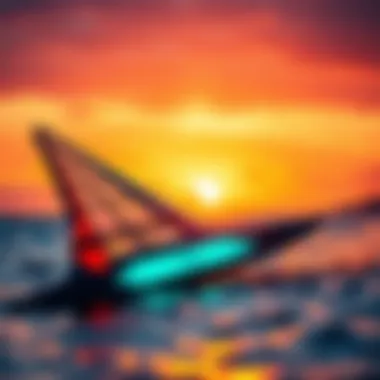

Moreover, as windsurfing communities become more aware of their footprint, events promoting eco-conscious riding are occurring globally, thus fostering a culture that not only respects the sport but the natural environment as well.
By embracing current trends, windsurfers not only elevate their experience but also contribute to the collective responsibility of protecting the oceans and ensuring the sport's future for generations to come.
Comparative Analysis with Other Boards
Understanding the distinctions between various board sports is critical for enthusiasts seeking to maximize their experience and performance. Windsurf wings, kiteboards, and surfboards each offer unique methodologies and experiences. Analyzing these sports not only highlights the strengths and weaknesses inherent in each but also how the windsurf wing has carved out a niche in the broader spectrum of water sports. This section aims to dissect key differences between windsurfing, kiteboarding, surfing, and foiling, illuminating how each caters to different preferences and skill levels.
Kiteboarding vs. Windsurfing
At first glance, kiteboarding and windsurfing might seem akin, given their shared reliance on wind. However, several fundamental differences set these boards apart, each providing distinct sensorial experiences on the water.
Similarities and Differences
- Wind Mechanics: While both sports harness wind for propulsion, kiteboarding uses a large kite tethered to the rider. This offers the advantage of jumping higher thanks to the dynamic lift provided by the kite. On the other hand, windsurfing employs a sail rigged directly onto the board. This creates a more stable experience, especially for those starting out.
- Control Techniques: Kiteboarders primarily manipulate the kite's position in the sky to control speed and direction. Conversely, windsurfers use their body weight and sail positioning to maneuver. This distinction can influence how each sport is learned: kiteboarding may require more initial effort to master kites and their controls, while windsurfing is more intuitive for some beginners.
- Accessibility in Various Conditions: Kiteboarding excels in light winds and is well suited for open water. Windsurfing shines in stronger winds, where the lift provided by the sail becomes more pronounced.
Ultimately, both sports have their ardent followers, and the choice between them often comes down to personal preference. Some riders enjoy the freedom of kiteboarding, while others appreciate the autonomy provided by the sail in windsurfing.
Surfing and Foiling Comparisons
Surfing and foiling represent different approaches to water dynamics and wave riding. Both these activities focus heavily on the ocean waves, yet their operational mechanics differ significantly, especially when compared to windsurfing.
Key Distinctions
- Wave Dependency: Surfing relies solely on ocean waves for propulsion, whereas foiling utilizes a hydrofoil attached to the board that can lift above the water once enough speed is generated. Windsurfing, conversely, combines both the use of wind and waves to create a multi-dimensional riding experience.
- Ride Experience: Surfing immerses riders in direct contact with the water, offering a visceral approach to wave riding. Foiling provides a surreal experience as riders skim above the water, minimizing drag and enhancing speed. Windsurfing offers a hybrid experience, merging the power of wind and the carve of waves.
- Skill Mastery: Surfing can require extensive practice to read wave patterns and timing, while foiling often demands a steep learning curve in terms of balance and control. Windsurfing similarly requires a grasp of wind dynamics and board control, but often provides more immediate feedback in varying conditions.
In the end, choosing between these board types hinges on what you seek from the water. Each sport offers a unique blend of skill and sensation, contributing to the mesmerizing world of water sports.
Regardless of the choice made, embracing the challenge and joy found in these water activities fuels a lifelong passion for many riders.
For more information on these board sports and their communities, check out resources like Wikipedia or join discussions on Reddit to further explore the diverse landscape of water sports.
Community and Culture
The culture surrounding windsurfing is as vast and multifaceted as the waters that enthusiasts ride upon. Communities play a vital role in not only advancing the sport but also in fostering friendships and shared experiences among participants. When one thinks about windsurfing, it’s often easy to focus on the technical aspects—the mechanics of the wing, the finesse required for turning—but the true essence is deeply rooted in its community. Understanding this aspect gives insight into the sport's warm camaraderie, a unique blend of skill enhancement and social interaction.
Global Windsurfing Communities
Windsurfing transcends borders, establishing communities across diverse environments, from the serene shores of Hawaii to the tumultuous waters of Cape Town. Each locale contributes distinct styles and approaches, influenced by local winds, terrains, and water conditions. For instance, the spot at Hookipa Beach is famed for its wild conditions and its community of freestyle windsurfers who are constantly pushing the limits of the sport.
Moreover, enthusiastic riders often share knowledge—tales of mishaps, successes, and techniques that tweak performance. This exchange is amplified in online forums like Reddit's r/windsurfing or Facebook groups dedicated to windsurf aficionados, where participants share videos, ask for advice, and critique new gear.
- Local Clubs: Many cities boast windsurfing clubs that offer support, camaraderie, and even group outings, allowing members to ride the waves together.
- Shared Passion: At its core, the dedication to windsport cultivates connections that often blossom into long-lasting friendships, providing a network of like-minded adventurers.
Benefits of Community Involvement
Being actively involved in a windsurfing community offers several benefits:
- Skill Development: With experienced riders willing to share their knowledge, newcomers can learn about safety protocols and performance techniques quickly.
- Access to Resources: Clubs often provide access to shared equipment, making it more affordable for enthusiasts to get started.
- Mental Health: Meeting like-minded individuals who share your passion can significantly enhance one’s motivation and mental wellness.
Events and Competitions
Wind festivals and competitions serve as the heartbeat of the windsurfing community, drawing in participants and spectators alike. Events such as the PWA (Professional Windsurfers Association) World Tour allow competitors to showcase their skills and passions. These gatherings not only provide a platform for both emerging and seasoned athletes but also inspire others who dream of surfing the waves one day.
- Local Races: Smaller races and competitions offer a chance for local riders to exhibit their skills against peers, making it a thrilling way to get involved.
- Workshops: Events frequently include workshops where instruction is delivered by professionals, further bridging the gap between varying levels of expertise within the community.
"The wind is a friend to many, but in competition, it becomes a rival to be bested."
Involvement in such events helps in establishing a sense of belonging for participants. They may find inspiration in others, fueling their passion further. Over time, these competitions have evolved with technology and trends, yet the foundational elements of community spirit remain steadfast.
In summary, the windsurfing community not only elevates the sport but also enriches the lives of those within it. This network provides opportunities for personal growth, shared experiences, and collective advancement that define the unique culture surrounding windsurfing.
The Future of Windsurf Wings
As the windsurfing landscape continues to evolve, the future of windsurf wings stands at a pivotal juncture. Riders are always on the lookout for ways to enhance their experience, whether it involves improved performance, sustainability, or simply making the sport more accessible. Understanding the trajectory of windsurf wings not only sheds light on the potential advancements but also helps enthusiasts and professionals alike to stay ahead of the curve. This section examines anticipated design innovations as well as the overall market growth that may shape the windsurfing community in the coming years.
Predictions in Design
Innovation drives the essence of sports equipment, and windsurf wings are no exception. Future designs will likely reflect a blend of advanced materials and innovative engineering. Here are a few notable predictions that stand to transform the windsurfing experience:
- Lightweight Composites: Expect to see the advent of lighter yet stronger materials, such as carbon fiber and new composite technologies that can endure the rigors of wind and water.
- Modular Designs: Future wings might adopt a modular approach, allowing users to customize configurations based on their preferences or riding conditions. This can revolutionize how players set up their gear before hitting the water.
- Aerodynamic Enhancements: Improved understanding of fluid dynamics can lead to wings engineered for better lift, reduced drag, and optimized performance across various wind conditions.
- Integration with Technology: Imagine wings embedded with sensors relaying real-time data about wind speed and direction, or even performance metrics that can be analyzed post-session. Tech-savvy riders will appreciate this kind of development.
"The shift towards smarter designs in windsurf wings isn't just a trend—it's a necessity in an ever-competitive and tech-driven world."
These predictions aren’t just pipe dreams; they come from observing existing trends and technological advancements across various industries. The possibilities are promising, and they can transform the riding experience, therefore attracting newcomers while retaining seasoned veterans.
Potential Market Growth
With the rising popularity of water sports and eco-consciousness taking center stage, the windsurf wing market is poised for notable growth. Several factors play into this anticipated expansion:
- Increased Participation Rates: The sport has been gaining traction, particularly among younger generations seeking adventure and novel experiences. More participants lead to a larger market.
- Sustainability Trends: With the growing emphasis on eco-friendly practices, manufacturers are likely to shift towards sustainable materials and production techniques. This not only attracts environmentally conscious consumers but also ensures long-term viability for the industry.
- Diverse Demographics: As windsurfing becomes more demographically inclusive, reaching out to diverse audiences can spur growth. Strategies to engage women, youth, and underrepresented demographics can widen the appeal of windsurf wings.
- Improvements in Technology: As previously mentioned, advancements can result in better products that enhance user experience, effectively marketing windsurf wings as state-of-the-art equipment.
In essence, the windsurf wing market looks to become a dynamic space filled with potential. Understanding these developments is crucial, not just for enthusiasts but also for investors and manufacturers aiming to tap into a growing segment of the water sports industry. As we look ahead, the winds of change seem favorable for those ready to embrace the future of windsurf wings.
For further information, check out resources from Wikipedia, Britannica, and community discussions on Reddit for insights about the windsurfing community.
